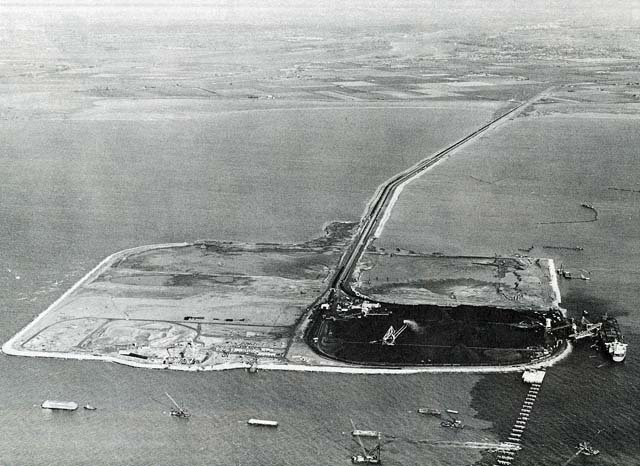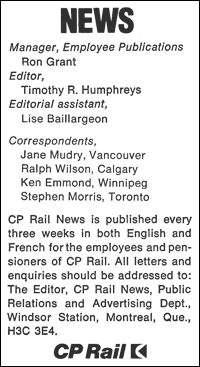|
|
Volume 13
Number 2 January 26, 1983 |

|
on the Coal Run
the challenge of the Selkirks.
by Jane Mudry

Vancouver - It's quite a stretch, 109 cars to be precise, from where locomotive engineer Vic Kavolinas sits at the throttle to the tail-end of the coal unit train and conductor Woody Heer.
Vic calls Woody with the "go-ahead" and the consist of empty cars starts slowly from the Roberts Bank super coal port on a 4 1/2 hour run to North Bend, 134 miles (215 kilometres) away, there a new crew will continue on.
Vic and Woody, along with trainmen Lew Fenske and Mike Pidsadny, are beginning the first leg of Number 5824's return trip to Sparwood, in southeastern British Columbia, where the train will be loaded with tons of export coal.
"It takes about 12 trains to load one of the largest bulk carriers that come into Roberts Bank," says the bespectacled Vic, who has been piloting unit trains out of Roberts Bank for the past decade.
MAN-MADE ISLAND
Roberts Bank is a man-made island in the Strait of Georgia, 15.5 miles (25 kilometres) south of Vancouver. It is linked to the mainland by a four mile long (6.4 kilometre long) causeway.
The first CP Rail unit train brought coal from southeastern B.C. to the port for export on 20 Apr 1970 and, while five railways are involved in the facility, only three actively use the port.
CP Rail accounts for greater than 90 percent of the traffic handled through Roberts Bank. In 1981, for example, 1,400 CP Rail coal cars transported 12.7 million tons (11.5 metric tons) of coal from Alberta and southeastern B.C. to the port in a continuous cycle of unit trains.
Railroaders sometimes refer to the coal unit trains as the "Cadillac" of trains because of their efficiency in getting the mined coal through the Selkirk mountains to port. They make few stops, usually just to change crews, on their 90 hour round trips.
Each unit train consists of specially designed rotary dump cars, or "bathtub" cars, which allow unloading of the coal at Roberts Bank without uncoupling the cars from the train.
Empty, the average coal unit train is powered by five diesel locomotives on the run to Sparwood, once loaded with 14,200 short tons (12,882 metric tons) of coal, 12 high powered locomotives are needed to push the consist through Rogers Pass.
Vic has been a locomotive engineer with CP Rail for 20 years and is looking forward to retiring within the next three years with 44 years of service with the company.
"I think I've worked in just about every terminal in B.C. at one time or another," he says.
"One of the jobs I remember the most clearly was the time I spent as a fireman shovelling coal on the run to Cranbrook... as much as 23 tons (20.8 metric tons) a run."
SLOW IN CANYON
Number 5824 travels along the Harbours Board, Burlington Northern, B.C. Hydro Rail, and CN tracks before moving along CP Rail lines for the trip up the Fraser Canyon.
It travels in a wide arc, avoiding major population centres of the lower mainland, passes through the tranquil agricultural flood plain of the Fraser Valley and joins the CP Rail main line just before Mission.
 "The fastest speed that we'll
travel is 50 miles per hour (80 kilometres per hour)," comments Vic. "A lot of the time, track speed is as slow as 10 to 25 mph (16 to 40
kph), especially in the canyon."
"The fastest speed that we'll
travel is 50 miles per hour (80 kilometres per hour)," comments Vic. "A lot of the time, track speed is as slow as 10 to 25 mph (16 to 40
kph), especially in the canyon."
Just outside Mission, the dispatcher in Vancouver, orders Vic to put Number 5824 into a hole, or siding. A few minutes later a fully loaded coal unit train passes on its way to Roberts Bank where its load will be discharged onto conveyor belts to storage piles or directly into the hold of an awaiting ship.
The Fraser Canyon has always been a challenge to railroaders. Between Hope and North Bend, there are dozens of tunnels of varying lengths, through which the coal unit trains thread their way.
Along the way, the trains pass small historic towns with interesting names like Ruby, Yale, Saddle Rock, and China Bar.
For Vic and others like him who have made this trip many times, the "Cadillac" of trains play an important role in getting Canada's coal to market.

